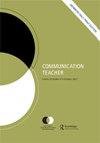The uses of conspiracy
IF 0.4
Q4 COMMUNICATION
引用次数: 0
Abstract
ABSTRACT This lesson offers students a way to analyze conspiracy theories while neither platforming dangerous ideas nor dismissing them as unworthy of academic study. Ideal for argument or rhetoric courses, first, the lesson advances conspiracy theories as a recognizable species of argument; second, the lesson uses a truncated version of Toulmin’s model of argument to equip students to engage the reasoning behind conspiratorial claims rather than the claim or its evidence. In so doing, students learn to isolate the most vulnerable part of an argument—what Toulmin calls its “warrant.” By the lesson’s end, students engage in an empathetic imagining of what makes conspiracy theories desirable in the first place, no matter their content, re-emphasizing rhetoric’s civic roots in a time of vitriol. Courses Argumentation and Debate, Rhetorical Criticism, Introduction to Communication, Political Communication, Persuasion. Objectives By the lesson’s end, students will be able to (1) identify the conspiracy theory as a form of public argument, (2) engage examples of the form with empathetic imagination, and (3) use the Toulmin model to evaluate arguments otherwise dismissed.阴谋的使用
摘要本课为学生提供了一种分析阴谋论的方法,既不将危险的想法平台化,也不认为它们不值得学术研究。这门课是辩论或修辞学课程的理想之选,首先,它将阴谋论作为一种可识别的论点;其次,本课使用了图尔明论证模型的截断版本,使学生能够参与阴谋主张背后的推理,而不是阴谋主张或其证据。在这样做的过程中,学生们学会了孤立争论中最脆弱的部分——图尔明所说的“理由”。在课程结束时,学生们对阴谋论的可取之处进行了富有同情心的想象,无论其内容如何,在尖酸刻薄的时代重新强调了修辞的公民根源。课程:辩论与辩论,修辞批评,交际概论,政治交际,说服。目的在课程结束时,学生将能够(1)将阴谋论确定为一种公开争论的形式,(2)用移情想象来参与这种形式的例子,以及(3)使用图尔明模型来评估否则被驳回的论点。
本文章由计算机程序翻译,如有差异,请以英文原文为准。
求助全文
约1分钟内获得全文
求助全文

 求助内容:
求助内容: 应助结果提醒方式:
应助结果提醒方式:


